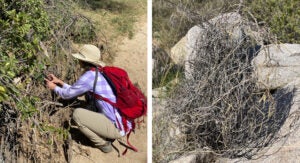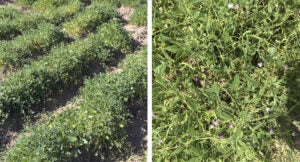Do wild varieties of overlooked grains, fruits, and vegetables hold the key to developing more resilient agriculture?
In late September, an international team of researchers fanned out across a remote New Mexico mountain range, in search of an elusive plant. The group trekked through the rugged landscape looking for signs of delicate vines hugging a tree, or lingering low on a dried creek bank.
After seven days in the desert scrubland, the scientists left with a sample of nature’s bounty: wild tepary bean plants.
The scientists wanted to collect the legume, which is native to arid regions of the southwestern United States and northwestern Mexico, for its hardy constitution: “They have evolved in this very hot, dry climate, so they have exceptional drought and heat tolerance, and potential tolerance to some extreme soil conditions as well,” said Sarah Dohle, a bean curator with the U.S. Department of Agriculture, who was part of the New Mexico collection effort.
Those qualities could prove beneficial on a warming planet, as scientists figure out how to breed beans, peppers, potatoes, and various other grains, fruits, and vegetables that can withstand the harsh conditions of a changing climate.
Such effects are already wreaking havoc on agriculture around the globe. In the western U.S., a severe drought crushed California’s tomato and rice production. In Guatemala, the combined effects of both drought and rain devastated corn and black bean harvests, both major food staples. In Sub-Saharan Africa, searing conditions have reduced yields of wheat and corn by more than a third since the early 1960s.
Climate and agricultural models predict a worsening scenario. The production of corn, a leading crop that feeds billions around the world, could decline by 24 percent as early as 2030, according to a 2021 study conducted by NASA. While other staple foods, such as wheat, may actually see an increase in production, researchers say it’s important to diversify agriculture in order to foster resilient and sustainable food systems. In 2014, only nine crops accounted for two-thirds of global production, out of more than 6,000 cultivated plant species and more than 50,000 edible plants found on the planet.
Underutilized and hardy crops like the tepary bean could help diversify food production, said Richard Pratt, a plant scientist and professor at New Mexico State University. And their genetic material may help make other crops more drought- and heat-tolerant. Pratt took part in the September expedition, along with colleagues from the USDA and the Colombia-based International Center for Tropical Agriculture, or CIAT. They’re among a growing number of researchers, plant breeders, and other scientists working to both preserve overlooked wild crops — keeping them safe for future generations — as well as breeding more resilient plants in the race to adapt to climate change.

To wit: The University of California, Davis, is leading a multi-state $15 million project involving 20 institutions to speed up the breeding cycles of wheat and to research ways to help the crop thrive in a toughened environment. At Auburn University in Alabama, scientists are working to breed a peanut variety that can better tolerate drought conditions. In parts of Asia and Africa, some farmers already grow a high-stress tolerant “green super rice” developed by the International Rice Research Institute in the Philippines. And scientists from various institutions have taken part in a sprawling effort, funded by the Norwegian government, to identify, collect, and evaluate wild crops for future development.
Still, there are numerous challenges at play: Crop breeding is a time-intensive process, so it can be difficult for researchers to keep pace with rapidly changing weather. Advances in genetic sequencing and gene editing can help speed up the process, but come with their own trials. Some researchers have cautioned that the gene editing technology Crispr, for example, may result in unintended changes to DNA and genetic contamination of crop wild relatives. Meanwhile, consumers still want foods that are flavorful. And farmers want crops that are easy to grow.
As hostile weather intensifies, plant breeding focused on climate-adapted crops has taken on a sense of urgency. “If global climate change keeps being hard on us,” Pratt said, “we’ve got to have crops that are resilient.”
Humans have a long history of domesticating and crossing wild plants to produce new generations with better flavor and higher yields. “Whether it is apples or pears or grapes or bananas that you eat from the supermarket, those plants have been domesticated by humans at one point somewhere in the world,” said ecologist Jesús García, a research associate with the Arizona-Sonora Desert Museum in Tucson, Arizona.
For example, about 9,000 years ago, early Indigenous farmers in current-day Mexico transformed wild teosinte, a type of grass, into the single-stalked, plump corn produced around the world today.
As the science of genetics evolved, plant scientists could better select for a plant’s more desirable traits, like taste, color, and size, and develop improved varieties for cultivation. But capturing such limited traits can result in less genetic diversity, which may make plants more susceptible to diseases, pests, and environmental impact. For example, the Irish Potato Famine was in part due to farmers propagating their plants so that each potato was a clone of itself. When a fungus started infecting the root vegetable in the 1840s, much of the crop fell to rot, and about 1 million people died from starvation.
“If global climate change keeps being hard on us, we’ve got to have crops that are resilient.”
To avoid a similar agricultural catastrophe, scientists such as Pratt are turning to wild varieties, since they could offer valuable genetic traits that may have been overlooked in decades past.“There’s still probably a lot of genetic diversity in the wild tepary populations that are not present in the cultivated teparies,” Pratt said. By crossing the wild specimen with a black bean or a pinto bean, for example, scientists may be able to breed a new variety that can better endure similar harsh environmental conditions that its relative thrived in.
The first step, though, is finding crops that can offer those hardier genetic traits in the wild.
Similar to how Pratt and his New Mexico team have searched for the wild tepary bean, other plant scientists are working to collect and preserve close wild cousins of crops that can help develop climate-adapted varieties and ensure food security for a burgeoning global population.
“Crop wild relatives just have a tolerance to more extreme conditions,” said Perin McNelis, native plant program manager for the Borderlands Restoration Network, a conservation nonprofit in Southern Arizona. “They don’t have nutrient-rich soils and daily watering, so they’re just hardier.”
The first step is finding crops that can offer those hardier genetic traits in the wild.
A couple of years ago, McNelis’ team set out with USDA staffers to collect the wild chiltepin that grows profusely under the protective shade of mesquite and ironwood trees in a vast protected area within the mountainous canyons of the borderlands. Scientists from near and far come to study the tiny, round red chiltepin, considered the mother of all peppers. The hot pepper also grows wild in parts of Texas, New Mexico, and Mexico.
The collection of wild chiltepin specimens, which were sent to USDA labs, McNelis said, will aid in future research and safeguarding of genetic material that may be used to breed improved crops.
A more massive collection of wild varieties of crops involved more than 100 scientists in 25 countries working with the Crop Trust, an international nonprofit based in Germany. The initiative, called the Crop Wild Relatives Project, was funded by the Norwegian government, and is co-managed by the Royal Botanic Gardens, Kew.
In 2018, scientists wrapped up six years of scouring far-reaching corners of the world for the wild plants. In its published report the following year, the organization said it had secured more than 4,600 seed samples of 371 wild relatives of domesticated crops, for distribution to global gene banks, which collect and store seeds, with the idea that scientists and breeders can then use those seeds for further research and development. Some of the varieties they found were not represented in the gene banks at all.
In some cases, collectors learned that some wild crops relatives had disappeared from their historical habitats. Others returned with specimens never collected before, including a tiny wild relative of the common bean growing near a Costa Rican beach. Scientists have already found useful traits in seed samples, including varying combinations of tolerance to drought, heat, and salinity in crops such as carrots, sorghum, and alfalfa.
“Crop wild relatives have been either ignored, forgotten, or seen as a threat to agriculture,” said Luis Salazar, a communications manager for the Crop Trust. “But they’ve been so resilient, they’ve been able to find a way to survive on their own.”
Those resilient traits, Salazar said, “are what we need now and what we’ll be needing more and more moving forward.”
Wild crop relatives may be tough, but they’re usually not suited for cultivation because they lack traits — such as good taste and rapid growth — that farmers want. The question, then, is how to develop new species that preserve the desirable traits of cultivated breeds, but are able to survive trying conditions.
Cultivating new plant species can take many approaches, but Pratt prefers conventional breeding methods: In New Mexico, he has grown different varieties of the viney, pod-bearing tepary plant on a campus field plot and other sites to see how well they adapt to the semi-arid soil. He selects plants with the characteristics he’s looking for, like drought resistance and high yield, which can then be used to create offspring with the desired characteristics.
As part of his research, Pratt has studied cultivated tepary varieties’ potential to produce high yields at different elevations and in mild to moderate drought stress. He’s found that “tepary beans don’t need as much water as common beans to produce a comparable yield,” he said.
With the hunt for wild teparies, Pratt and his colleagues hope to boost representation of the resilient bean in the collections of seeds, plants, and tissue cultures that gene banks preserve worldwide and share with farmers to feed the world. But, Pratt said, there’s still a lot of discussion about how best to integrate that beneficial genetic material into common beans that succumb to the heat or can potentially improve the hardiness of cultivated tepary beans.

Conventional breeding is not without limitations. It can often take many years to produce desired results, and selecting specific genetic characteristics without pulling in unwanted traits can be difficult.
Advances in genetic technologies have made it possible to speed up plant breeding. A plant’s genes are like a blueprint, outlining how it will look and what traits it will have. Plant geneticists can identify specific genes of interest in those blueprints more quickly than they have in the past, due largely to increasingly powerful DNA sequencing, which essentially read through the plants’ genetic material to identify genes and the traits that they control.
Scientists at McGill University in Montreal, for example, have sequenced the DNA of nearly 300 types of potatoes, including wild varieties, to create a “super pangenome” — a species’ entire set of genes. To do this, the researchers used gene banks, such as the ones that the Wild Crop Relatives Project helped populate. Sequencing the DNA is something like a roadmap that makes it easier to select traits that make potatoes more resistant to disease and environmental burdens, said Shelley Jansky, a longtime research geneticist with the USDA.
“That pangenome really gives us a very powerful tool for manipulating the genetics of the potato and creating potato plants that are better than what we have,” said Jansky, who recently retired and was not involved in the research, but specializes in potato genetics.
By reading and identifying the genetic information contained in the cells of plants, the years it takes to develop a new crop variety can be reduced from up to two decades to just a few years. Plant breeders can still use conventional methods, such as those used by Pratt with his tepary beans, to cultivate crops but, by using DNA sequencing, they significantly cut down on the grow time. For example, if a breeder wants to be sure the apple tree he’s growing will produce red apples, he can scan a seed’s DNA for that trait to determine what color apples the tree will produce, rather than wait for a tree to grow and mature to find out.
Some scientists involved in the Crop Wild Relatives Project have also used DNA sequencing to isolate select traits in the wild crops — such as salt tolerance — and incorporate them into a new gene line in a process called “pre-breeding.” As of mid-2021, its project partners have incorporated genetic material from wild varieties in order to develop more than 14,000 new lines of 19 crops. Most of that material is stored in various gene banks around the world, and many have not been cultivated, but some have been shared with farmers to see how they react in local conditions.
“We involve them in evaluations to understand what they want, and that plays into the picture,” Salazar said. “Farmers are not interested in wild relatives as just wild relatives. What they want is a plant that’s going to deliver better than what’s out there right now.”
Such crops aren’t considered to be genetically engineered, but gene editing — in particular Crispr — also makes it possible to introduce new genetic traits into a plant far faster than before. Crispr more or less allows scientists to modify a plants’ genetic blueprint to cut, copy, or paste specific genes in and out.
“Breeding technologies evolve, and this what we see right now in soybean breeding with the first applications of gene editing through CRISPR,” Daniel Debouck, one of the scientists from CIAT who joined the New Mexico expedition, wrote in an email to Undark. It seems reasonable, he said, that other beans, such as the tepary, may be the focus of the technology in the coming years.
Genetically engineered crops still carry a stigma, though, and are regulated more heavily than their conventionally grown counterparts. But, between 2019 and 2020, the number of gene-edited crops approved by the U.S. Department of Agriculture jumped from 7 to 70. Meanwhile, there is no consensus on gene edited crops around the world. While some countries and regions deem the technology safe and acceptable in food production, others are more cautious.
Back in southwestern New Mexico’s Sky Islands mountainous region, which rises from mesquite-speckled desert to oak-studded terrain across four states and two countries, Pratt and his colleagues carefully inspected the landscape for signs of the tepary bean.
The scientists found the wild ancestor of the cultivated tepary where it’s known to grow best: between 4,500 and 6,000 feet high. They also gathered three other related species that have not been cultivated. And despite rescuing a relatively low number of seeds, the scientists brought back some plants, soil samples, and valuable field observations.
The collectors had figured that early October would be an optimum time for tepary seed maturity. But the late arrival of this year’s meager monsoon rains in the region delayed the plant’s growth, he said. “They’re still immature and the plants that grew last year were completely dry and had already shed the seed,” Pratt said.
“It may just be that for a couple of decades we’re growing what we can grow and not necessarily what we want to grow. And we’ve got to be prepared for that.”
Dohle, with the USDA, will plant the seeds to grow tepary beans in a Pullman, Washington greenhouse and multiply the number of seeds to distribute freely to researchers and plant breeders. “That’s going to take months,” she said.
The fall expedition reinforced Pratt’s belief in the importance of collecting crop wild relatives that may be in danger of disappearing in scorching temperatures and urban encroachment. He has gone back to the wild a few times in recent months to save seeds from still-maturing plants.
A crucial step, he said, is to secure the variation in the genetic resources of plants so that breeders and others can access them to address different needs as they work to improve crops for a drier, hotter planet.
“It may just be that for a couple of decades we’re growing what we can grow and not necessarily what we want to grow,” Pratt said. “And we’ve got to be prepared for that.”
Lourdes Medrano is a journalist based in Southern Arizona, and a senior contributor at Undark. Her reporting often focuses on matters relevant to both sides of the U.S.-Mexico border, including environmental issues.
This article was originally published on Undark. Read the original article.


